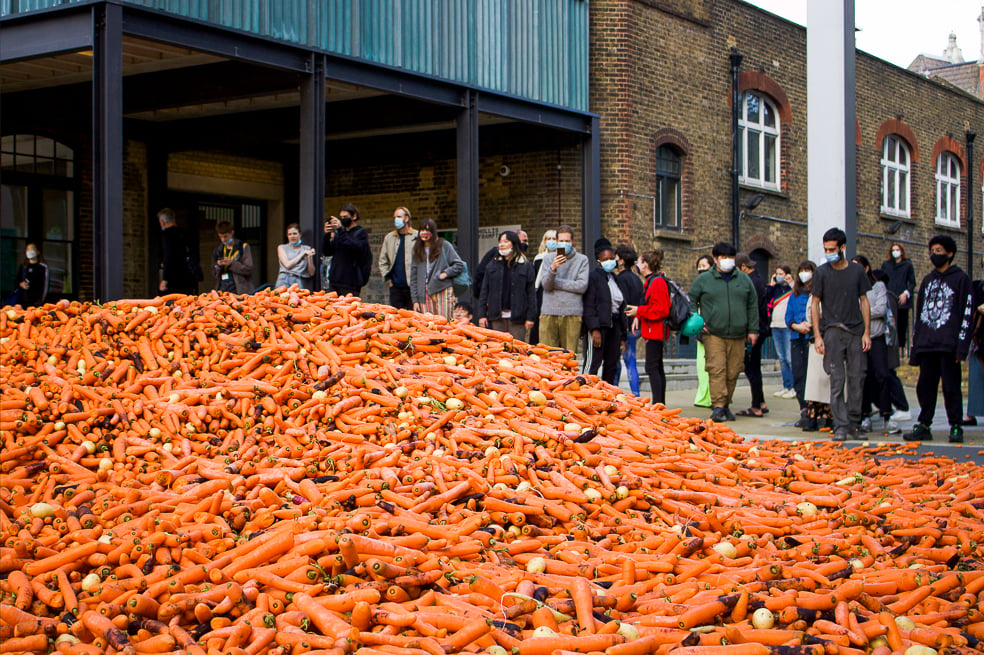
There are approximately 240,000 carrots—and an unquantified number of potatoes—sitting outside of London’s Goldsmiths College. The massive pile of root vegetables, weighing in at 31 tons, is an art project, on view as part of the school’s annual MFA exhibition.
The performance component of the site-specific work by Rafael Pérez Evans, titled Grounding (2020), took place on Tuesday, when a large red tractor-trailer dumped the carrots on the ground in an orange tidal wave that swept through the college courtyard.
Evans, who grew up in a family of farmers in Spain, was inspired by a protest tactic popular among farmers, particularly in France, called dumping. To protest cratering produce prices, farmers will pile up carrots or potatoes in the street, the vegetables becoming a physical roadblock and serving as a highly visible reminder of farmers’ oft-ignored labor. It’s a practice that has intrigued the artist since childhood.
“On one occasion when I was quite young, I remember people being very angry and upset as the cost of lemons had been devalued to such an extreme that it was costing the farmers money to sell their stock,” Evans told Artnet News in an email. “This issue made many farmers dump, in protest, tons of lemons, creating a sort of sea of yellow. This I guess was the first moment in which I became aware of the power of how governmental devaluation and international trade affected farmers.”
Staging Grounding in London is Evans’s way of reminding viewers of where their food comes from, and to consider the relationship our cities have with rural farmers. The work’s title comes from the therapeutic technique of grounding, or reconnecting with the earth and its electrical energy.
“In the city, we are not very connected to the processes of how the things we consume are produced, under which circumstances and conditions,” Evans explained. “Looking into peasant culture, ecology, farming, and the soil is a way to reorient my compass into finding other ways of relating which perhaps aren’t so detached from land, plants, and foods.”
Soon after the work’s installation, photos and videos began circulating on social media, to the extreme confusion of many. But Goldsmiths was quick to explain the art connection when Times of London journalist George Greenwood—who is now describing himself as an “accidental carrot correspondent”—took to Twitter to investigate the “carrot conundrum.”
The artwork has drawn some criticism for contributing to global food loss, with a group of four Goldsmiths students launching an Instagram account, @goldsmithscarrots, to protest “this incredibly wasteful art piece.”
“Lewisham is one of the poorest boroughs in London and this mass dumping of carrots at Goldsmiths is beyond insensitive,” the group wrote. “It’s a massive slap in the face.”
Evans says he actually wants Grounding, which is accompanied by a sign warning that the carrots are “not for human consumption,” to highlight the existing waste in food production systems.
Evans went to a bulk animal feed provider to purchase the vegetables, which have been rejected by UK supermarkets and judged to be “animal grade” carrots. When the exhibition ends next week, the carrots will be donated to farms to feed livestock, as originally intended.
“How can carrots that look perfectly fit but not be fit for human consumption and supermarkets but okay for animals is part of the question in the work,” he explained. “The issues around waste are very important.”
But the students behind @goldsmithscarrots aren’t taking Evans’s word for it. They have been busy collecting, peeling, and grating the carrot pile to make vegan carrot cake and carrot soup. The group, which estimated yesterday that it had only used .3 percent of the carrots so far, is holding daily bake sales next to the artwork and donating the proceeds—reportedly nearly £700 ($900) over the first two days—to local food banks.
For his part, Evans is “very happy that more artists are responding and creating new artworks, and dialogues around the questions that the piece ignites.”
The initial performance was livestreamed on Facebook and can be watched here. In-person visiting hours are 10 a.m. to 5 p.m., except for the exhibition’s final day, which is open until 7 p.m.
See more photos of Grounding below.
Rafael Pérez Evans, Grounding (2020) at Goldsmiths College, London. Photo courtesy of the artist.
Rafael Pérez Evans, Grounding (2020) at Goldsmiths College, London. Photo courtesy of the artist.
“MFA Exhibition” is on view at Goldsmiths College, Ben Pimlott Building, St. James’s, New Cross, London SE14 6NH, October 2–October 6, 2020.